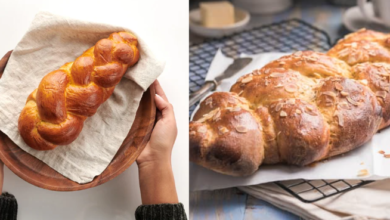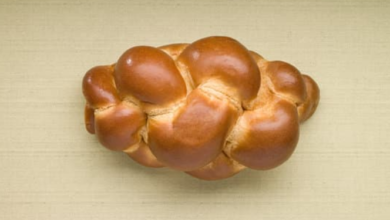How Is Challah Different From Other Breads?

What To Know
- The amount of water in the dough affects the hydration level of the bread, resulting in a softer or firmer crumb.
- Challah bread is made with a unique combination of ingredients, including eggs and honey, which give it a richer flavor and a softer texture than white bread.
- The braiding of challah bread is a traditional practice that adds visual appeal and affects the texture of the bread.
Challah bread, a traditional Jewish bread, stands out from the crowd with its unique characteristics that set it apart from other bread varieties. Its golden-brown crust, soft and fluffy interior, and intricate braiding patterns are just a few of the features that make challah bread a beloved culinary icon. In this comprehensive guide, we delve into the intricacies of what makes challah bread different, exploring its history, ingredients, preparation methods, and the cultural significance it holds.
The History of Challah Bread
Challah bread has a rich history that dates back to biblical times. In the Torah, challah is mentioned as a special bread that was offered to priests as part of religious rituals. Over the centuries, challah bread has become an integral part of Jewish culture, symbolizing abundance, celebration, and community.
The Unique Ingredients of Challah Bread
Unlike ordinary bread, challah bread is crafted using a specific combination of ingredients that contribute to its distinctive flavor and texture. Here are the key ingredients that make challah bread different:
- Flour: High-quality bread flour or unbleached all-purpose flour forms the backbone of challah bread, providing structure and a chewy texture.
- Water: The amount of water in the dough affects the hydration level of the bread, resulting in a softer or firmer crumb.
- Yeast: Active dry yeast or instant yeast is used as a leavening agent, creating air pockets that give challah bread its characteristic fluffy interior.
- Eggs: Eggs are a crucial ingredient that adds richness, flavor, and a golden-brown color to the crust.
- Sugar: A small amount of sugar provides nourishment for the yeast and contributes to the sweetness and flavor of the bread.
- Salt: Salt balances the sweetness of the dough and enhances the overall flavor profile.
The Braiding of Challah Bread
One of the most striking features of challah bread is its intricate braiding. The braiding process not only adds visual appeal but also affects the texture of the bread. The number of strands used in the braiding can vary, with popular options including three, four, or six strands.
The Preparation of Challah Bread
The preparation of challah bread requires careful attention to detail and a precise process. Here are the steps involved in making challah bread:
1. Mixing the Dough: The ingredients are combined in a large bowl and mixed until a smooth, elastic dough forms.
2. Kneading: The dough is kneaded for several minutes to develop the gluten and create a strong structure.
3. Rising: The dough is allowed to rise in a warm place until it doubles in size.
4. Dividing and Shaping: The risen dough is divided into equal portions and shaped into long strands.
5. Braiding: The strands are braided according to the desired pattern.
6. Second Rising: The braided dough is allowed to rise again until it has almost doubled in size.
7. Baking: The challah bread is baked in a preheated oven until golden brown.
The Cultural Significance of Challah Bread
Challah bread holds a special place in Jewish culture and is often associated with holidays and celebrations. It is traditionally eaten on the Sabbath (Shabbat) and other Jewish holidays, symbolizing the abundance and joy of the occasion. Challah bread is also used in religious ceremonies, such as the Havdalah service that marks the end of the Sabbath.
The Health Benefits of Challah Bread
While challah bread is not typically considered a health food, it does offer certain nutritional benefits. It is a good source of carbohydrates, which provide energy, and it contains protein, fiber, and vitamins. However, it is important to note that challah bread is also high in calories and fat, so moderation is key.
Quick Answers to Your FAQs
- What is the difference between challah bread and white bread?
Challah bread is made with a unique combination of ingredients, including eggs and honey, which give it a richer flavor and a softer texture than white bread.
- Why is challah bread braided?
The braiding of challah bread is a traditional practice that adds visual appeal and affects the texture of the bread.
- Is challah bread kosher?
Challah bread is considered kosher as long as it is made with kosher ingredients and prepared according to Jewish dietary laws.
- Can challah bread be frozen?
Yes, challah bread can be frozen for up to 3 months. To freeze, wrap the bread tightly in plastic wrap and place it in a freezer bag.
- How do I reheat challah bread?
Challah bread can be reheated in a preheated oven at 350°F (175°C) for 5-10 minutes, or in a toaster oven until warm.





